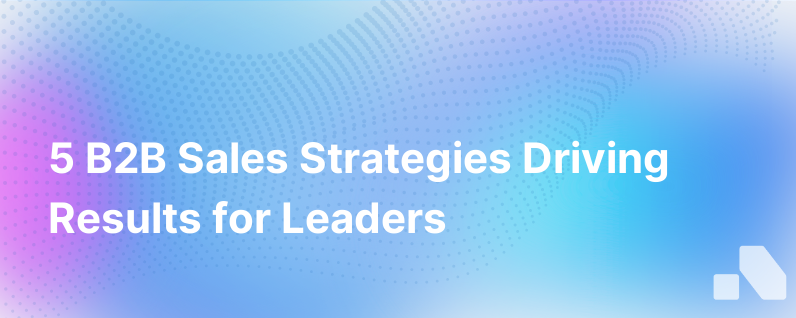
In the realm of business-to-business (B2B) sales, the stakes are high and the competition fierce. The complexity of B2B transactions—with their long sales cycles, multiple stakeholders, and sizable contracts—demands a set of strategic approaches quite different from those used in direct-to-consumer markets. What follows is an in-depth exploration of five cutting-edge strategies that can give B2B sales teams the edge they need to thrive in this challenging arena.
1. Challenger Sales Model
The Challenger Sales Model is a sales approach rooted in the idea that the key to winning business is not just about building relationships, but about challenging a customer's thinking. The successful 'Challenger' salesperson teaches, tailors, and takes control of the sales process.
- Teach: Offer valuable insights and solutions that customers may not have been aware of. This establishes credibility and authority.
- Tailor: Customize your messaging and solutions to the specific needs and pain points of each potential client.
- Take Control: Guide the sales conversation to focus on the value and differentiated benefits of your offerings.
Implementing the Challenger model involves a shift from a purely relationship-driven approach to a value-driven model, where the sales professional becomes a trusted advisor.
2. Account-Based Selling
Account-Based Selling (ABS) is a strategic approach that treats high-value accounts as markets in their own right. It's a collaborative strategy that involves aligning sales, marketing, and customer success teams around the goal of winning and growing specific accounts.
Steps in ABS include:
- Selecting target accounts based on agreed criteria, like industry, revenue, or strategic fit.
- Creating highly personalized campaigns tailored to the specific business issues and opportunities for each target account.
- Engaging multiple decision-makers and stakeholders within the target organizations through tailored messaging and solutions.
ABS is most effective when supported by a CRM that tracks all engagement with target accounts and integrates with marketing automation tools.
3. Solution Selling
Solution Selling is about diagnosing the customer's unique needs and recommending products or services that solve specific business problems. This approach relies less on selling a product and more on framing the product as the key to a solution.
Key elements of Solution Selling include:
- Deep discovery to understand the prospect's challenges and desired outcomes.
- Framing discussions around the customer's issues rather than product features.
- Demonstrating how your offering can solve specific problems and create value for their business.
Training and ongoing learning are important for sales teams to remain consultative and effectively leverage solution selling.
4. Social Selling
Social Selling leverages social networks and personal branding to enable sales professionals to connect with and nurture leads through social channels like LinkedIn, Twitter, or industry-specific online communities. It transforms cold outreach into warm connections.
The core tactics in Social Selling involve:
- Building a strong, credible sales presence online.
- Sharing and creating content that adds value and establishes subject matter expertise.
- Using social listening tools to identify opportunities to engage prospects in meaningful conversations.
Social Selling is particularly impactful when combined with other sales methodologies and requires persistence and consistency to see results.
5. Sales Enablement
Sales Enablement is the process of providing sales organizations with the information, content, and tools that help salespeople sell more effectively. The foundation of sales enablement is to provide salespeople with what they need to engage the buyer throughout the buying process.
Sales enablement focuses on:
- Equipping sales teams with up-to-date and easily accessible content such as case studies, product sheets, and industry reports.
- Providing training and materials that help reps understand buyer personas.
- Leveraging technology to streamline the sales process and provide actionable analytics.
- Ensuring that sales strategies and attribution are aligned across sales and marketing teams.
A dedicated sales enablement strategy can result in more efficient sales processes and improved success rates in closing deals.
In Practice: Adapting Strategies for Your B2B Sales Team
While the above strategies each have their own strengths, the best approach for your business will likely involve a tailored blend that aligns with your specific goals, industry, and sales cycle.
For example, a B2B SaaS company selling a complex, enterprise-level product might focus heavily on Account-Based Selling and Sales Enablement, ensuring they're crafting a tailored pitch for each high-value lead and supporting their team with the tools and content they need to succeed.
On the other hand, a B2B organization selling more standardized, lower-cost solutions might invest more in Solution Selling and Social Selling, aiming to quickly identify customer pain points and connect with a larger volume of leads through social channels.
No matter which strategies you choose to adopt, remember that the B2B sales landscape is always evolving. Keep your strategies fresh and adaptive, and continually invest in training your sales force to be proficient across these approaches. Technology plays a key role here too, facilitating data analysis, enabling real-time communications, and ensuring that updated sales materials are always at your team's fingertips.
In a dynamic and data-rich sales environment, tools like Aomni can help streamline the sales process by providing real-time insights and personalized content at scale. Aomni's AI platform minimizes effort and maximizes strategic selling, making it an ideal complement to the modern B2B sales strategies discussed in this article.